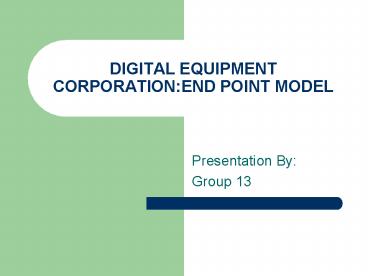DIGITAL EQUIPMENT CORPORATION:END POINT MODEL - PowerPoint PPT Presentation
1 / 15
Title:
DIGITAL EQUIPMENT CORPORATION:END POINT MODEL
Description:
How is EPM (Virtual Integration) different from Vertical Integration? ... Disjointed information flow. Present Situation. Cycle time too high:40 weeks ... – PowerPoint PPT presentation
Number of Views:1468
Avg rating:5.0/5.0
Title: DIGITAL EQUIPMENT CORPORATION:END POINT MODEL
1
DIGITAL EQUIPMENT CORPORATIONEND POINT MODEL
- Presentation By
- Group 13
2
Basic Tasks Involved
- Analysis of present situation at DSM
- Scope for Improvement
- Evaluation of End Point Model (EPM)
- How is EPM (Virtual Integration) different from
Vertical Integration?
3
Problems with the old system
- Old system had a variety of computer-related
systems in place each was a discrete entity - Software was tailored to the needs of each
individual area - Disjointed information flow
4
Present Situation
- Cycle time too high40 weeks
- Component Test and burn-in6-8 weeks
- Module Assembly20 weeks
- System Integration6-8 weeks
- Distribution6 weeks
- Target to reduce this cycle time to 15 days
5
Scope for improvement
- Cycle time consists of
- information
transaction75 - (This can be reduced
significantly) - material transaction25
- Hardwired network is already in place.
6
ENDPOINT MODEL PLAN
- Focuses on integrating 4 elements
- System Information and management tools
- Control
- Physical Manufacturing Processes
- Programs and Philosophies
7
Advantages and Disadvantages of Endpoint Model
- Reduction in information flow time
- Management discipline
- Accountability in demand forecasts
- Accurate inventory records
- Intricate system
- Hard to implement
- Dealing with change
8
(No Transcript)
9
Cycle time reduction??
- Eliminating component test of incoming materials
leads to increased reliability on the suppliers - Eliminates system integration can increase
Defect Rate - Enormous pressure on the Board Assembly Line to
produce defect free products.
10
Networking. A Boon
- Reduces Cycle Time radically
- Streamline flow of information from suppliers to
manufacturer , manufacturer to customers and
within the organization itself. - Enhance the financial and performance statistics
of the organization
11
Is the Network too Entangled???
- Failure of a single link can halt the system.
- Thus Redundant Links Required
- Cost is increased
- Scalability required
12
Vertical Integration
- Integrates the supply chain by moving upstream
and downstream the supply chain. - Reduce costs, improve quality, timely delivery
and increase market share by owning and
coordinating components of the system. - Purchasing the organizations is very costly.
- Can result in sizable debt and have negative
affect on the competitive position.
13
Virtual Integration
- Similarity attempts to link the components of an
integrated system to operate as a single entity. - Different means Links the core competencies of
individual organizations through cost-sharing and
risk-sharing agreements so that these
organizations can act as a larger, single entity.
14
Virtual Integration (cont.)
- Organizations continue to operate as separate
entities, giving them opportunities to pursue
business in other areas. - Integrates entity without investing huge amounts
of capital or completely altering their
structures. - Draws on the positive aspects of vertical
integration without creating sizable debt for the
parent organization.
15
- THANK YOU































